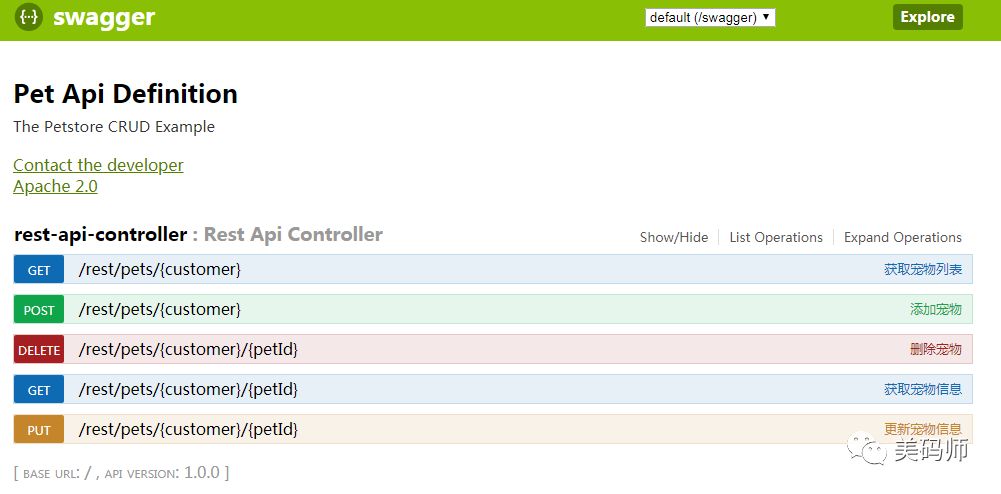SpringBoot RESTful实战
一、目标
了解 Restful 是什么,基本概念及风格;
能使用SpringBoot 实现一套基础的 Restful 风格接口;
利用Swagger 生成清晰的接口文档。
二、Restful 入门
什么是REST
摘自百科的定义:REST即表述性状态转移(英文:Representational State Transfer,简称REST) 是Roy Fielding博士(HTTP规范主要贡献者)在2000年的论文中提出来的一种软件架构风格。 是一种针对网络应用的设计和开发方式,可以降低开发的复杂性,提高系统的可伸缩性。
通俗点说,REST就是一组架构约束准则;在这些准则中,有不少是利用了现有的WEB标准能力。 而最终的目的则是简化当前业务层的设计及开发工作。
Restful API 则是指符合REST架构约束的API,关于这个词在早年前其实已经非常流行,但大多数开发者对其仍然 处于观望状态,并不一定会立即采用。这个相信与当时技术社区的成熟度及氛围是密切相关。 无论如何,在微服务架构如此流行的今天,Restful API已经成为了一种必备的的标准设计风格。
关键要点
理解 Restful 风格需要理解以下几点:
资源
资源指的就是一个抽象的信息实体,可以是一个用户、一首歌曲、一篇文章,只要是可作为引用的对象就是资源。 每个资源通常会被映射到一个URI,通过访问这个URI可以获取到信息。
资源的表述
资源表述(Representation)指的则是资源的外在表现形式 比如一个帖子,可以通过HTML格式展现,也可以通过XML、JSON等格式输出到客户端。
在前面的文章(SpringBoot-Scope详解)中提到,HTTP协议通过MIME来统一定义数据信息的格式标准。 通常,Accept、Content-Type可以用来指定客户端及服务端可接受的信息格式,而这个就是资源的表述
状态转移
在HTTP访问过程中,资源的状态发生变化。这里会涉及到以下的几个动词:
| 名称 | 语义 |
|---|---|
| GET | 获取资源 |
| POST | 新建资源 |
| PUT | 更新资源 |
| DELETE | 删除资源 |
对于不同的访问方法,服务器会产生对应的行为并促使资源状态产生转换。
关于无状态
Restful 是无状态的设计,这点意味着交互过程中的请求应该能包含所有需要的信息,而不需要依赖于已有的上下文。 然而 JavaEE中存在一些违背的做法,比如Cookie中设置JSESSIONID, 在多次请求间传递该值作为会话唯一标识,这标识着服务端必须保存着这些会话状态数据。
PlayFramework框架实现了无状态的Session,其将会话数据经过加密编码并置入Cookie中, 这样客户端的请求将直接携带上全部的信息,是无状态的请求**,这点非常有利于服务端的可扩展性。
三、SpringBoot 实现 Restful
接下来,我们利用 SpringBoot 来实现一个Restful 风格的样例。
说明基于 PetStore(宠物店) 的案例,实现对某顾客(Customer)名下的宠物(Pet)的增删改查。
1. 实体定义
Customer
publicclassCustomer{privateString name;publicCustomer(){super();}publicCustomer(String name){super();this.name = name;}publicString getName(){return name;}publicvoid setName(String name){this.name = name;}}
Customer 只包含一个name属性,我们假定这是唯一的标志。
Pet
publicclassPet{privateString petId;privateString name;privateString type;privateString description;publicString getPetId(){return petId;}publicvoid setPetId(String petId){this.petId = petId;}publicString getName(){return name;}publicvoid setName(String name){this.name = name;}publicString getType(){return type;}publicvoid setType(String type){this.type = type;}publicString getDescription(){return description;}publicvoid setDescription(String description){this.description = description;}}
Pet 包含了以下几个属性
| 属性名 | 描述 |
|---|---|
| petId | 宠物ID编号 |
| name | 宠物名称 |
| type | 宠物类型 |
| description | 宠物的描述 |
2. URL资源
基于Restful 的原则,我们定义了以下的一组URL:
| 接口 | 方法 | URL |
|---|---|---|
| 添加宠物 | POST | /rest/pets/{customer} |
| 获取宠物列表 | GET | /rest/pets/{customer} |
| 获取宠物信息 | GET | /rest/pets/{customer}/{petId} |
| 更新宠物信息 | PUT | /rest/pets/{customer}/{petId} |
| 删除宠物 | DELETE | /rest/pets/{customer}/{petId} |
3. 数据管理
接下来实现一个PetManager 类,用于模拟在内存中对Pet数据进行增删改查 代码如下:
@ComponentpublicclassPetManager{privatestaticMap<String,Customer> customers =newConcurrentHashMap<String,Customer>();privatestaticMap<String,Map<String,Pet>> pets =newConcurrentHashMap<String,Map<String,Pet>>();@PostConstructpublicvoid init(){String[] customerNames =newString[]{"Lilei","Hanmeimei","Jim Green"};for(String customerName : customerNames){customers.put(customerName,newCustomer(customerName));}}/*** 获取customer** @param customer* @return*/publicCustomer getCustomer(String customer){if(StringUtils.isEmpty(customer)){returnnull;}return customers.get(customer);}/*** 获取customer名下的 pet 列表** @param customer* @return*/publicList<Pet> getPets(String customer){if(StringUtils.isEmpty(customer)){returnCollections.emptyList();}if(!pets.containsKey(customer)){returnCollections.emptyList();}return pets.get(customer).values().stream().collect(Collectors.toList());}/*** 获取某个pet** @param customer* @param petId* @return*/publicPet getPet(String customer,String petId){if(StringUtils.isEmpty(customer)||StringUtils.isEmpty(petId)){returnnull;}if(!pets.containsKey(customer)){returnnull;}return pets.get(customer).get(petId);}/*** 删除pet** @param customer* @param petId* @return*/publicboolean removePet(String customer,String petId){if(StringUtils.isEmpty(customer)||StringUtils.isEmpty(petId)){returnfalse;}if(!pets.containsKey(customer)){returnfalse;}return pets.get(customer).remove(petId)!=null;}/*** 添加pet** @param customer* @param pet* @return*/publicPet addPet(String customer,Pet pet){if(StringUtils.isEmpty(customer)|| pet ==null){returnnull;}Map<String,Pet> customerPets =null;if(!pets.containsKey(customer)){customerPets =newLinkedHashMap<String,Pet>();Map<String,Pet> previous = pets.putIfAbsent(customer, customerPets);// 已经存在if(previous !=null){customerPets = previous;}}else{customerPets = pets.get(customer);}if(pet.getPetId()==null){pet.setPetId(UUID.randomUUID().toString());}customerPets.put(pet.getPetId(), pet);return pet;}/*** 更新某个pet** @param customer* @param petPojo* @return*/publicPet updatePet(String customer,Pet petPojo){if(StringUtils.isEmpty(customer)|| petPojo ==null){returnnull;}if(petPojo.getPetId()==null){returnnull;}Pet pet = getPet(customer, petPojo.getPetId());pet.setType(petPojo.getType());pet.setName(petPojo.getName());pet.setDescription(petPojo.getDescription());return pet;}}
4. 控制层实现
SpringBoot 提供了 @RestController,用于快速定义一个Restful 风格的Controller类@RestController=@ResponseBody + @Controller
@RestController@RequestMapping("/rest/pets/{customer}")publicclassRestApiController{@AutowiredprivatePetManager dataManager;/*** 添加宠物** @param customer* @param pet* @return*/@PostMappingpublicResponseEntity<Object> addPet(@PathVariableString customer,@RequestBodyPet pet){validateCustomer(customer);Pet newPet = dataManager.addPet(customer, pet);// 返回 201.createdif(newPet !=null){URI location =ServletUriComponentsBuilder.fromCurrentRequest().path("/{petId}").buildAndExpand(newPet.getPetId()).toUri();returnResponseEntity.created(location).build();}// 返回 204.noContentreturnResponseEntity.noContent().build();}/*** 获取宠物列表** @param customer* @return*/@GetMapping@ResponseBodypublicList<Pet> listPets(@PathVariableString customer){validateCustomer(customer);List<Pet> pets = dataManager.getPets(customer);return pets;}/*** 获取某个宠物** @param customer* @param petId*/@GetMapping("/{petId}")@ResponseBodypublicPet getPet(@PathVariableString customer,@PathVariableString petId){validateCustomer(customer);validatePet(customer, petId);Pet pet = dataManager.getPet(customer, petId);return pet;}/*** 更新宠物信息** @param customer* @param petId* @param pet*/@PutMapping("/{petId}")publicResponseEntity<Object> updatePet(@PathVariableString customer,@PathVariableString petId,@RequestBodyPet pet){validateCustomer(customer);validatePet(customer, petId);pet.setPetId(petId);Pet petObject = dataManager.updatePet(customer, pet);if(petObject !=null){returnResponseEntity.ok(petObject);}returnResponseEntity.noContent().build();}/*** 删除某个宠物** @param customer* @param petId* @return*/@DeleteMapping("/{petId}")publicResponseEntity<Object> removePet(@PathVariableString customer,@PathVariableString petId){validateCustomer(customer);validatePet(customer, petId);dataManager.removePet(customer, petId);returnResponseEntity.ok().build();}
上述代码中已经实现了完整的增删改查语义。 在Restful 风格的API 接口定义中,往往会引用 HTTP 状态码用于表示不同的结果,比如一些错误的状态类型。
这里我们对Customer、Pet 进行存在性校验,若资源不存在返回404_NotFound。
/*** 校验customer是否存在** @param customer*/privatevoid validateCustomer(String customer){if(dataManager.getCustomer(customer)==null){thrownewObjectNotFoundException(String.format("the customer['%s'] is not found", customer));}}/*** 校验pet是否存在** @param customer*/privatevoid validatePet(String customer,String petId){if(dataManager.getPet(customer, petId)==null){thrownewObjectNotFoundException(String.format("the pet['%s/%s'] is not found", customer, petId));}}
自定义异常拦截
/*** 自定义异常,及拦截逻辑** @author atp**/@SuppressWarnings("serial")publicstaticclassObjectNotFoundExceptionextendsRuntimeException{publicObjectNotFoundException(String msg){super(msg);}}@ResponseBody@ExceptionHandler(ObjectNotFoundException.class)@ResponseStatus(HttpStatus.NOT_FOUND)publicString objectNotFoundExceptionHandler(ObjectNotFoundException ex){return ex.getMessage();}
5. 接口验证
1. 添加宠物
URLPOST http://{{server}}/rest/pets/LiLei请求内容
{"name":"Smart Baby","description":"very small and smart also.","type":"Dog"}
返回示例
201 createdContent-Length→0Date→Mon,09Jul201805:15:01 GMTLocation→http://localhost:8090/rest/pets/LiLei/b5400334-e7b3-42f1-b192-f5e7c3193543
2. 获取宠物列表
URLGET http://{{server}}/rest/pets/LiLei请求内容
返回示例
200 OKContent-Type→application/json;charset=UTF-8Date→Mon,09Jul201805:23:27 GMTTransfer-Encoding→chunked[{"petId":"b5400334-e7b3-42f1-b192-f5e7c3193543","name":"Smart Baby","type":"Dog","description":"very small and smart also."},{"petId":"610780af-94f1-4011-a175-7a0f3895163d","name":"Big Cat","type":"Cat","description":"very old but I like it."}]
3. 查询宠物信息
URLGET http://{{server}}/rest/pets/LiLei/b5400334-e7b3-42f1-b192-f5e7c3193543请求内容
返回示例
200 OKContent-Type→application/json;charset=UTF-8Date→Mon,09Jul201805:25:24 GMTTransfer-Encoding→chunked{"petId":"b5400334-e7b3-42f1-b192-f5e7c3193543","name":"Smart Baby","type":"Dog","description":"very small and smart also."}
4. 更新宠物信息
URLPUT http://{{server}}/rest/pets/LiLei/b5400334-e7b3-42f1-b192-f5e7c3193543请求内容
{"name":"Big Cat V2","description":"I don't like it any more","type":"Cat"}
返回示例
200 OKContent-Type→application/json;charset=UTF-8Date→Mon,09Jul201805:31:28 GMTTransfer-Encoding→chunked{"petId":"a98e4478-e754-4969-851b-bcaccd67263e","name":"Big Cat V2","type":"Cat","description":"I don't like it any more"}
5. 删除宠物
URLDELETE http://{{server}}/rest/pets/LiLei/b5400334-e7b3-42f1-b192-f5e7c3193543请求内容
返回示例
200 OKContent-Length→0Date→Mon,09Jul201805:32:51 GMT
相关出错
客户不存在:404 the customer['test'] is not found
宠物不存在:404 the pet['LiLei/b5400334-e7b3-42f1-b192-f5e7c31935431'] is not found
四、Swagger 的使用
关于Swagger
Swagger是目前非常流行的一个API设计开发框架(基于OpenApi), 可用于API的设计、管理、代码生成以及Mock测试等。
目前Swagger的应用非常广,其涵盖的开源模块也比较多,这里将使用swagger-ui实现API在线DOC的生成。
引入依赖
io.springfox springfox-swagger2 2.7.0 io.springfox springfox-swagger-ui 2.7.0
定义API配置
@EnableSwagger2@ConfigurationpublicclassSwaggerConfig{publicstaticfinalString VERSION ="1.0.0";@Value("${swagger.enable}")privateboolean enabled;ApiInfo apiInfo(){returnnewApiInfoBuilder().title("Pet Api Definition").description("The Petstore CRUD Example").license("Apache 2.0").licenseUrl("http://www.apache.org/licenses/LICENSE-2.0.html").termsOfServiceUrl("").version(VERSION).contact(newContact("","","zalesfoo@163.com")).build();}@BeanpublicDocket customImplementation(){returnnewDocket(DocumentationType.SWAGGER_2).select().apis(RequestHandlerSelectors.withClassAnnotation(Api.class)).build().enable(enabled).apiInfo(apiInfo());}}
@EnableSwagger2声明了Swagger的启用,Docket的Bean定义是API配置的入口, 可以设置API名称、版本号,扫描范围等。
声明API描述
在原有的Controller 方法上添加关于API的声明,如下:
@Api(value ="Pet Restful api")@RestController@RequestMapping("/rest/pets/{customer}")publicclassRestApiController{@ApiOperation("添加宠物")@ApiImplicitParams({@ApiImplicitParam(paramType ="path", name ="customer", dataType ="String", required =true, value ="客户名", defaultValue =""),@ApiImplicitParam(paramType ="body", name ="pet", dataType ="Pet", required =true, value ="pet 请求", defaultValue ="")})@ApiResponses({@ApiResponse(code =201, message ="添加成功"),@ApiResponse(code =404, message ="资源不存在")})@PostMappingpublicResponseEntity<Object> addPet(@PathVariableString customer,@RequestBodyPet pet){...
为了能描述返回对象的文档说明,为Pet类做API声明:
@ApiModel("宠物信息")publicclassPet{@ApiModelProperty(name="petId", value="宠物ID")privateString petId;@ApiModelProperty(name="name", value="宠物名称")privateString name;@ApiModelProperty(name="type", value="宠物类型")privateString type;@ApiModelProperty(name="description", value="宠物描述")privateString description;
相关的注解:
| 注解 | 描述 |
|---|---|
| @ApiModelProperty | 用在出入参数对象的字段上 |
| @Api | 用于controller类 |
| @ApiOperation | 用于controller方法,描述操作 |
| @ApiResponses | 用于controller方法,描述响应 |
| @ApiResponse | 用于@ApiResponses内,描述单个响应结果 |
| @ApiImplicitParams | 用于controller的方法,描述入参 |
| @ApiImplicitParam | 用于@ApiImplicitParams内,描述单个入参 |
| @ApiModel | 用于返回对象类 |
访问文档
最后,访问 http://localhost:8000/swagger_ui.html,可看到生成的文档界面:

两年呕心沥血的文章:「面试题」「基础」「进阶」这里全都有!
300多篇原创技术文章加入交流群学习海量视频资源精美脑图面试题长按扫码可关注获取
在看和分享对我非常重要!![]()
